

Marc Furigay – The Case of the Dead Musician. Anton Karazai had amassed a great fortune in his seventy years as a world-famous pianist, performing for presidents and parliaments, kings and queens, in all the greatest cities’ concert halls and children’s hospitals.
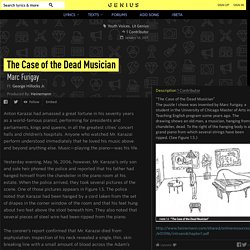
Anyone who watched Mr. Karazai perform understood immediately that he loved his music above and beyond anything else. Music—playing the piano—was his life. Yesterday evening, May 16, 2006, however, Mr. Karazai’s only son and sole heir phoned the police and reported that his father had hanged himself from the chandelier in the piano room at his estate. The coroner’s report confirmed that Mr. May 16, 2006. The Assignment. Educational Leadership:Feedback for Learning:Teaching Argument. Robert J.
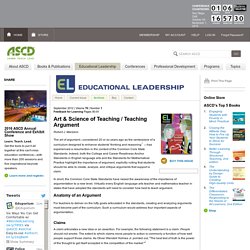
Marzano The art of argument—considered 20 or so years ago as the centerpiece of a curriculum designed to enhance students' thinking and reasoning1 —has experienced a resurrection in the context of the Common Core State Standards. Indeed, both the College and Career Readiness Anchor Standards in English language arts and the Standards for Mathematical Practice highlight the importance of argument, explicitly noting that students should be able to create, analyze, and critique arguments that support a claim. In short, the Common Core State Standards have raised the awareness of the importance of argumentation to a new level. Virtually every English language arts teacher and mathematics teacher in states that have adopted the standards will need to consider how best to teach argument.
Anatomy of an Argument For teachers to deliver on the lofty goals articulated in the standards, creating and analyzing arguments must become part of the curriculum. Claims. We the Students Essay Contest - Bill of Rights Institute. We the Students – Essay Contest The Bill of Rights Institute is delighted to announce the winners of the 2014 We the Students Scholarship contest: 1st Place: John Marando 2nd Place: Jackson Min 3rd Place: Sarah Kwate Honorable Mentions: Jonathan Huntley Samuel Rice Alyssa Wise Lauren Lenaburg Lillian Bartholomew We The Students – Video Contest The winner of the 2014 We the Students Scholarship Video Contest is Nathan Wheeler.

The We the Students Essay Contest has closed. Tchng Arg & Content Monte Sano. Argument Writing. The previous unit focused on practices that support the reading and analysis of text for developing interpretations.
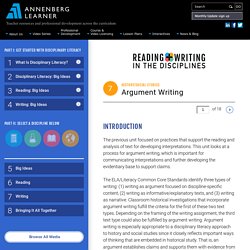
This unit looks at a process for argument writing, which is important for communicating interpretations and further developing the evidentiary base to support claims. The ELA/Literacy Common Core Standards identify three types of writing: (1) writing as argument focused on discipline-specific content, (2) writing as informative/explanatory texts, and (3) writing as narrative. Classroom historical investigations that incorporate argument writing fulfill the criteria for the first of these two text types. Depending on the framing of the writing assignment, the third text type could also be fulfilled by argument writing. Argument writing is especially appropriate to a disciplinary literacy approach to history and social studies since it closely reflects important ways of thinking that are embedded in historical study. Common Core Shifts. Common Core writing standards require History/Social Science teachers to become writing teachers.

Yet many are uncomfortable in this role, they are more accustomed to being experts in their content area and K-12 writing is a foreign language reserved for ELA teachers with their own glossary of terms and acronyms. This post will demonstrate how History teachers can continue delivering content while coaching good writing skills and creating positive classroom attitudes toward writing. This argumentative writing task on eugenics tested students in three ways: (1) interpreting and gathering evidence; (2) developing a thesis, and (3) supporting their thesis. After listening to a lecture on eugenics, students did a quick write where they took a position on whether eugenics was positive or negative, then they conducted a gallery walk where they collected evidence that supported their argument.
SRSD Writing in History. This post is a follow up to my earlier lecture on SRSD writing instruction.
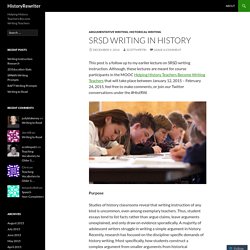
Although, these lectures are meant for course participants in the MOOC Helping History Teachers Become Writing Teachers that will take place between January 12, 2015 – February 24, 2015, feel free to make comments, or join our Twitter conversations under the #HistRW. Purpose Studies of history classrooms reveal that writing instruction of any kind is uncommon, even among exemplary teachers. Thus, student essays tend to list facts rather than argue claims, leave arguments unexplained, and only draw on evidence sporadically. A majority of adolescent writers struggle in writing a simple argument in history. What Makes a Good History Essay? Assessing Historical Aspects of Argumentative Writing. Teaching students to write standard arguments in history classes is certainly worthwhile; teaching them to write historical arguments is even more so.

Learning history and historical thinking can help students become better writers, especially if we learn to look for the historical qualities in their writing and support their development. In this article from Social Education (NCSS 2012), author Chauncey Monte-Sano shares findings from a research study she conducted that helped her begin to define historical qualities of adolescents’ argumentative writing and recognize the interconnectedness of writing and history. WWII MEAL Paragraphs.
This is a follow-up from an earlier post and video lecture explaining how to use MEAL paragraphs as routine writing tasks that help students build stronger body paragraphs.

Many classes start with a “Warm Up” that is used to hook students into the lesson, or in this case textbook. In order to use MEAL paragraphs in this fashion, the instructor merely needs to pose an arguable question that requires students to take a position, then find three pieces of textual evidence and explain how the evidence supports their main idea. Finally, they link their evidence and analysis back to the main idea of the paragraph. HistoryRewriter.
Please note: This post was adapted from a PowerPoint posted online from Ms.

Kelly Flynn, a teacher at St. John’s College High School in Washington DC. The changes I have made have been to make this post shorter and more appropriate for history and social studies students. M.E.A.L. paragraphs are method of writing strong paragraphs. DAA - University Writing Center - History's Tropes. The five-paragraph model, often taught in middle school, is not a model that is well suited to an extended research project.
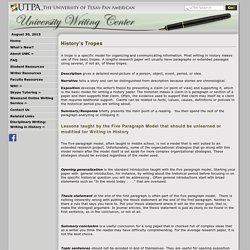
Unfortunately, some of the organizational strategies that go along with this model remain after the model itself is set aside for more complex organizational strategies. These strategies should be avoided regardless of the model used. Opening generalization is the standard introduction taught with the five paragraph model. Starting your paper with general introduction, for instance, by writing about the historical period before focusing in on the specific historical question you will be addressing . Often general introductions start with broad statements such as “In the world today . . ..” that are overused. ELA Lesson Planning: Evidence And Arguments. Build an argument. Batreecr. Writing a Thesis and Making an Argument. Teaching Argument Writing, Grades 6-12 by George Hillocks Jr. "In this book, George Hillocks teaches us not only what an argument is, but how to teach it and why we should.
Essential reading for those preparing ALL students to think critically, write well, and succeed academically in both high school and college. " -Jim Burke, Author of The English Teacher's Companion and What's the Big Idea? Argument writing can be difficult to teach, but it may be the most important set of skills we teach in English. According to the National Common Core Standards, by the end of high school, students should be able to write arguments to support claims with clear reason and relevant evidence—and they should be able to do so well. Hillocks Ch 1. Teaching Arguments. Product Details Author: Jennifer FletcherISBN: 978-157110-999-6Year: 2015Media: 288 pp/paperGrade Range: 9-12Item No: WEB-0999 No matter where students' lives lead after graduation, one of the most essential tools we can teach them is how to comprehend, analyze, and respond to arguments. Students need to know how writers' and speakers' choices are shaped by elements of the rhetorical situation, including audience, occasion, and purpose.
In Teaching Arguments, Jennifer Fletcher provides teachers with engaging classroom activities, writing prompts, graphic organizers, and student samples to help students at all levels read, write, listen, speak, and think rhetorically. ArgueLab.